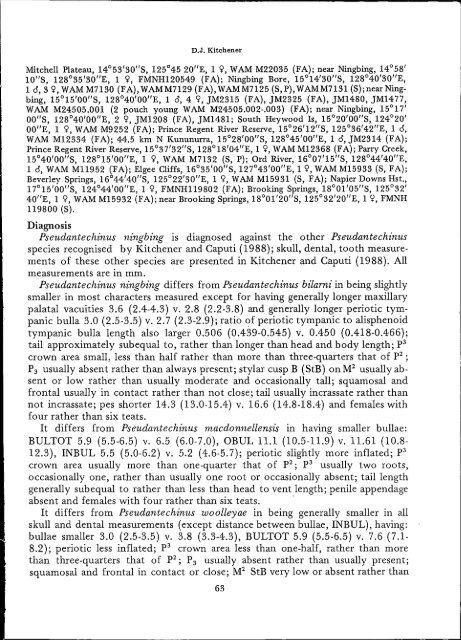a new species of false antechinus (marsupialia dasyuridae)
a new species of false antechinus (marsupialia dasyuridae)
a new species of false antechinus (marsupialia dasyuridae)
Create successful ePaper yourself
Turn your PDF publications into a flip-book with our unique Google optimized e-Paper software.
D.J. Kitchener<br />
Mitchell Plateau, 14°53'30"S, 125°45 20"E, 1 ~, WAM M22035 (FA); near Ningbing, 14°58'<br />
10"S, 128°35'30"E, 1 ~, FMNH120549 (FA); Ningbing Bore, 15°14'30"S, 128°40'30"E,<br />
1 0, 3~, WAM M7130 (FA), WAMM7129 (FA), WAMM7125 (S,P), WAMM7131 (S);nearNingbing,<br />
15°15'00"S, 128°40'00"E, 1 0, 4 ~,JM2315 (FA), JM2325 (FA), JM1480, JMI477,<br />
WAM M24505.001 (2 pouch young WAM M24505.002-.003) (FA); near Ningbing, 15°17'<br />
OO"S, 128°40'OO"E, 2 ~,JMI208 (FA), JM1481; South Heywood Is, 15°20'OO"S, 124°20'<br />
OO"E, 1 ~, WAM M9252 (FA); Prince Regent River Reserve, 15°26'12"S, 125°36'42"E, 1 0,<br />
WAM M12334 (FA); 44.5 km N Kununurra, 15°28'OO"S, 128°45 I OO"E, 1 0, JM2314 (FA);<br />
Prince Regent River Reserve, 15°37'32"S, 128°18'04"E, 1 ~, WAM M12368 (FA); Parry Creek,<br />
15°40 1 00"S 128°15'00"E 1 ~ WAM M7132 (S P)· Ord River 16°07'15"S 128°44'40"E<br />
1 0, WAM M11952 (FA); Elgee'Cliffs, 16°35'OOI'S, 127°43'OO"E: 1~, WAM M15933 (S, FA);<br />
Beverley Springs, 16°44'40"S, 125°22'30'IE, 1 ~, WAM M15931 (S, FA); Napier Downs Hst.,<br />
17°15 I OO"S, 124°44'OO"E, 1 ~, FMNH119802 (FA); Brooking Springs, 18°0I'05"S, 125°32'<br />
40"E, 1 ~, WAM M15932 (FA); near Brooking Springs, 18°01'20"S, 125°32'20"E, 1 ~, FMNH<br />
119800 (S).<br />
Diagnosis<br />
Pseud<strong>antechinus</strong> ningbing is diagnosed against the other Pseud<strong>antechinus</strong><br />
<strong>species</strong> recognised by Kitchener and Caputi (1988); skull, dental, tooth measurements<br />
<strong>of</strong> these other <strong>species</strong> are presented in Kitchener and Caputi (1988). All<br />
measurements are in mm.<br />
Pseud<strong>antechinus</strong> ningbing differs from Pseud<strong>antechinus</strong> bilarni in being slightly<br />
smaller in most characters measured except for having generally longer maxillary<br />
palatal vacuities 3.6 (2.4-4.3) v. 2.8 (2.2-3.8) and generally longer periotic tympanic<br />
bulla 3.0 (2.5-3.5) v. 2.7 (2.3-2.9); ratio <strong>of</strong> periotic tympanic to alisphenoid<br />
tympanic bulla length also larger 0.506 (0.439-0.545) v. 0.450 (0.418-0.466);<br />
tail approximately subequal to, rather than longer than head and body length; p3<br />
crown area small, less than half rather than more than three-quarters that <strong>of</strong> p2 ;<br />
P3 usually absent rather than always present; stylar cusp B (StB) on M 2 usuallyabsent<br />
or low rather than usually moderate and occasionally tall; squamosal and<br />
frontal usually in contact rather than not close; tail usually incrassate rather than<br />
not incrassate; pes shorter 14.3 (13.0-15.4) v. 16.6 (14.8-18.4) and females with<br />
four rather than six teats.<br />
It differs from Pseud<strong>antechinus</strong> macdonnellensis in having smaller bullae:<br />
BULTOT 5.9 (5.5-6.5) v. 6.5 (6.0-7.0), OBUL 11.1 (10.5-11.9) v. 11.61 (10.8<br />
12.3), INBUL 5.5 (5.0-6.2) v. 5.2 (4.6-5.7); periotic slightly more inflated; p3<br />
crown area usually more than one-quarter that <strong>of</strong> p2; p3 usually two roots,<br />
occasionally one, rather than usually one root or occasionally absent; tail length<br />
generally subequal to rather than less than head to vent length; penile appendage<br />
absent and females with four rather than six teats. .<br />
It differs from Pseud<strong>antechinus</strong> woolleyae in being generally smaller in all<br />
skull and dental measurements (except distance between bullae, INBUL), having:<br />
bullae smaller 3.0 (2.5-3.5) v. 3.8 (3.3-4.3), BULTOT 5.9 (5.5-6.5) v. 7.6 (7.1<br />
8.2); periotic less inflated; p3 crown area less than one-half, rather than more<br />
than three-quarters that <strong>of</strong> p2; P3 usually absent rather than usually present;<br />
squamosal and frontal in contact or close; M 2 StB very low or absent rather than<br />
63
















